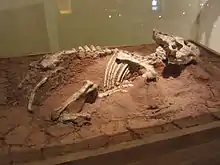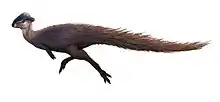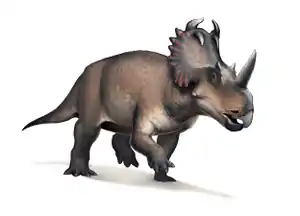Auroraceratops
Auroraceratops, meaning "dawn horned face", is a genus of bipedal basal neoceratopsian dinosaur, from the Early Cretaceous (Aptian age) of north central China. The etymology of the generic name refers to its status as an early ceratopsian and also to Dawn Dodson, wife of Peter Dodson, one of the palaeontologists who described it.
| Auroraceratops Temporal range: Early Cretaceous, | |
|---|---|
 | |
| Partially prepared specimen of A. rugosus | |
| Scientific classification | |
| Domain: | Eukaryota |
| Kingdom: | Animalia |
| Phylum: | Chordata |
| Clade: | Dinosauria |
| Clade: | †Ornithischia |
| Suborder: | †Ceratopsia |
| Infraorder: | †Neoceratopsia |
| Genus: | †Auroraceratops You et al., 2005 |
| Species: | †A. rugosus |
| Binomial name | |
| †Auroraceratops rugosus You et al., 2005 | |
Discovery and species
The first specimen was found in the Xinminpu Group, Gongpoquan Basin of the Mazong Shan area of Gansu Province, north central China.[1] As of 2021, fossils from more than 80 more individuals have been found, including complete skeletons.[2]
The specific descriptor, "rugosus", Latin for "rough", refers to the various rugose areas on the surface of both skull and jaw, namely the wrinkled expansion of the lacrimal bone distinctive of this animal. Auroraceratops is the second basal neoceratopsian to be found in the Mazong Shan area, after Archaeoceratops.
The type specimen, IG-2004-VD-001, consists of a nearly complete subadult skull lacking the rostral bone and parietal crest.
Description
Though most other neoceratopsians are characterized by a long, narrow snout, Auroraceratops has a shorter wider one. The 20 cm (8 in) skull itself is rather flat and wide. The premaxillae have at least two pairs of striated fang-like teeth. Paired rugose areas, very probably covered in keratin in life, are in front of the eyes and on the jugal with corresponding areas on the lower jaw. These roughened knobs were likely to have been used for inter- and intra-specific interactions. While they would not have been much use as a physical defense against predators, another possible function for these structures would be in pushing or butting contests between members of the same species either for mating rights or social disputes.

Auroraceratops is a rather derived moderate-sized basal neoceratopsian that adds diversity to that clade, displaying skull features not present in Archaeoceratops or Liaoceratops. A detailed analysis of the post-cranial skeleton published in 2019 showed that the animal would have walked bipedally and had an estimated length of 1.25 m (4.1 ft), hip height of 44 cm (17 in) and body mass of 15.5 kg (34 lb).[3]
See also
References
- You, H.; Li, D.; Ji, Q.; Lamanna, H.; Dodson, P. (2005). "On a new genus of basal Neoceratopsian dinosaur from the Early Cretaceous of Gansu Province, China". Acta Geologica Sinica. 79 (5): 593–597.
- Baillie, Katherine Unger (July 12, 2019). "Small horned dinosaur from China, a Triceratops relative, walked on two feet". Penn Today. Retrieved 16 July 2019.
- Morschhauser, E.M.; You, H.; Li, D.; Dodson, P. (July 2019). "Postcranial morphology of the basal neoceratopsian (Ornithischia: Ceratopsia) Auroraceratops rugosus from the Early Cretaceous (Aptian–Albian) of northwestern Gansu Province, China". Journal of Vertebrate Paleontology. 38 (sup 1): 75–116. doi:10.1080/02724634.2018.1524383. S2CID 202867095.

.png.webp)


